Rapid changes in student demand as the US loses market share

The United States has long stood as a global powerhouse in higher education—home to world-renowned institutions, cutting-edge research, and academic opportunities that attract hundreds of thousands of international students each year. With its diverse programmes, innovative learning environments, and influential alumni networks, US institutions have consistently ranked as some of the most sought-after study abroad options.
However, recent and rapid shifts in political discourse and policy—ranging from funding threats to changes in diversity and free speech regulations—are beginning to cast uncertainty over this reputation. As these developments unfold, emerging data from Studyportals reveals early signs of shifting student demand, prompting questions about how US institutions can continue to sustain their dominance in the global education arena.
Slipping from a top position amongst the Big Four
In early 2023, the US was positioned as the 4th study destination in terms of international student demand (i.e. pageviews). This gradually shifting towards 2nd as the introduction of unfavorable visa and student capping policies in both the UK and Canada respectively led to lower demand for on-campus Bachelor and Master offers.
However, this was not meant to be as demand leading up to and after the US presidential elections notably stagnated before it slightly declined into 2025. Instead, student demand appears to be returning for UK offers, a potential trend that has been espoused in a recent article by the British Council, highlighting that current and prospective students may view the UK as a more stable and welcoming alternative, with its very similar academic reputation, streamlined visa policies, and renewed government focus on boosting international student numbers.
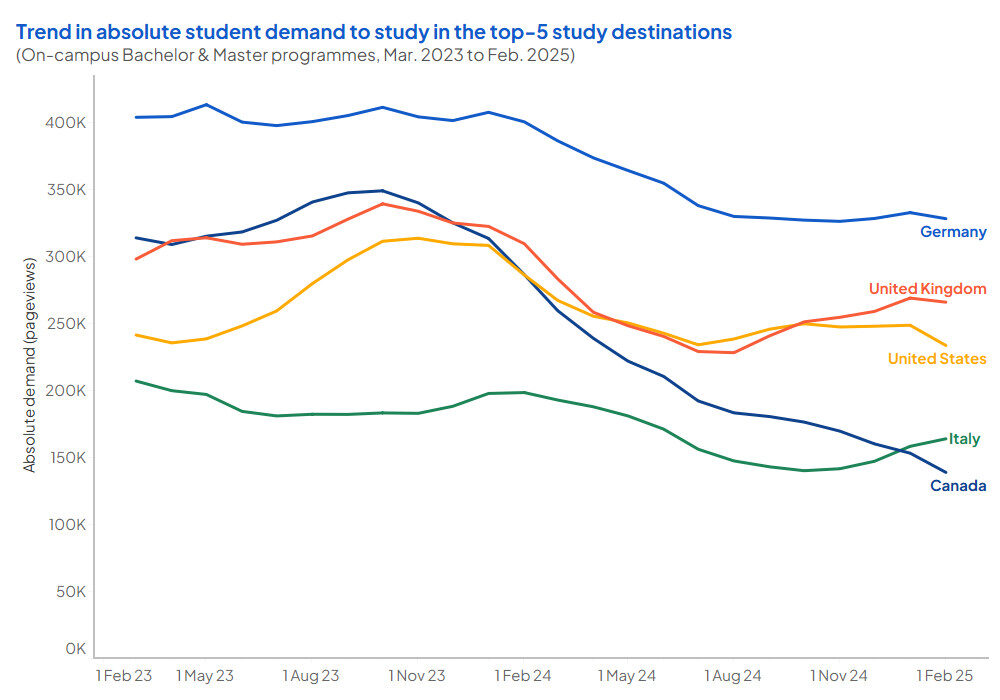
Weighing US and international demand prospects
That being said, to say that the position of the US is at serious risk of slipping is not entirely a reality just yet. According to student search sessions when students look at an on-campus Bachelor or Master study from the US over the last six months, only 6.8% of those sessions saw prospective students also consider a programme from the UK. Furthermore, this stands at 3.6% of sessions that also looked at Canadian programmes, 2.6% for German studies, and 1.3% for Italian offers.
That being said, it is also worth noting that when comparing the change in the share of search sessions, then the share for the UK grew by 19.2% over the last 6 months compared to the previous 6 months, with notable growth across the five most popular discipline fields searched for by prospective students.
Furthermore, while weekly demand from domestic U.S. students for local study options declined by 10.3% since the first week of January, interest in certain international destinations—such as the UK—rose notably following Trump’s inauguration. Despite these shifts, the U.S. still holds a dominant position among top global study destinations.
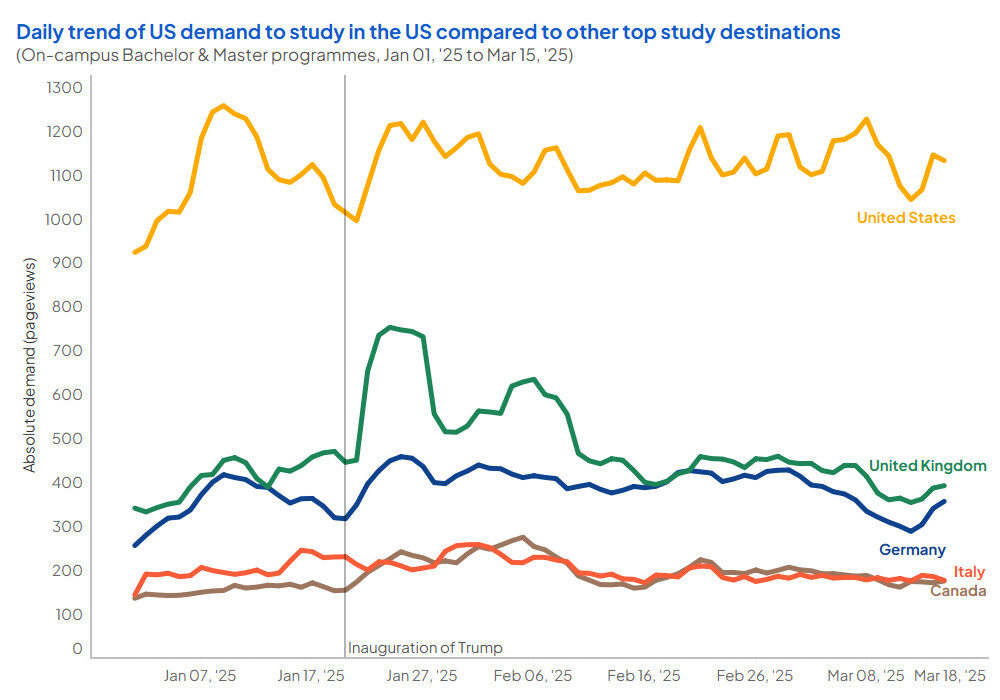
If the lens is slightly adjusted to instead consider the developments for Master and PhD programmes in the US, then weekly demand from an international audience fell by 38% between the week starting 5th January and 9th March. Considering the impact by top US state, then demand for these offers in New York dropped by 38.3%, followed by Texas (-36.9%), Florida (-33.4%), California (-32.0%), and Massachusetts (-19.5%).
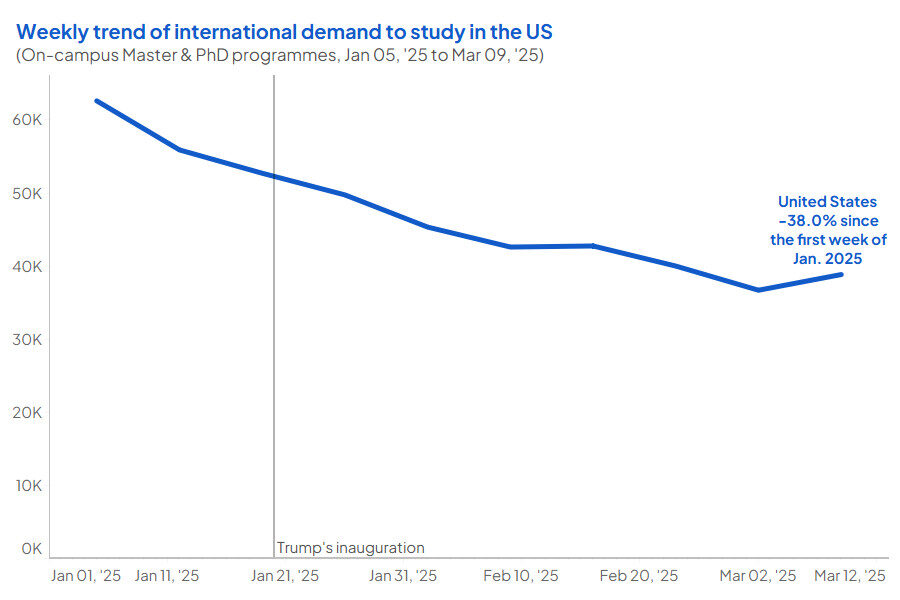
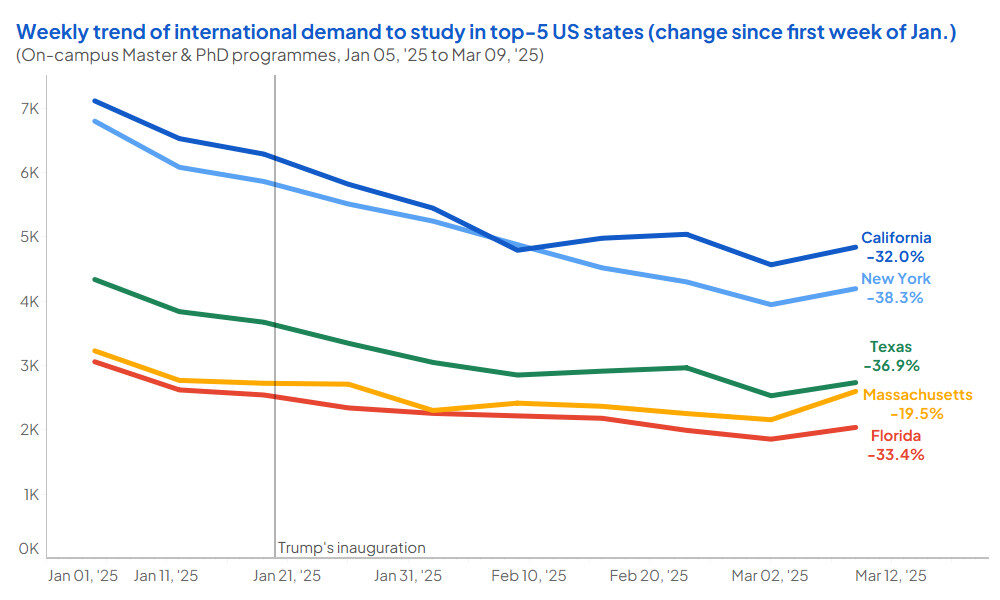
The main markets that are driving this decline include India, Bangladesh, Pakistan, Nigeria, and Iran, with the latter indicating the largest decline (-61.2%), followed by a steep fall from Bangladesh (-54.1%). At the same time, the sense of uncertainty in student decision may be evident by the fluctuated demand generated per week, as prospective Indian and Bangladeshi demand rose by 16.1% and 9.9% respectively, and modestly from prospective Pakistani and Nigerian students.
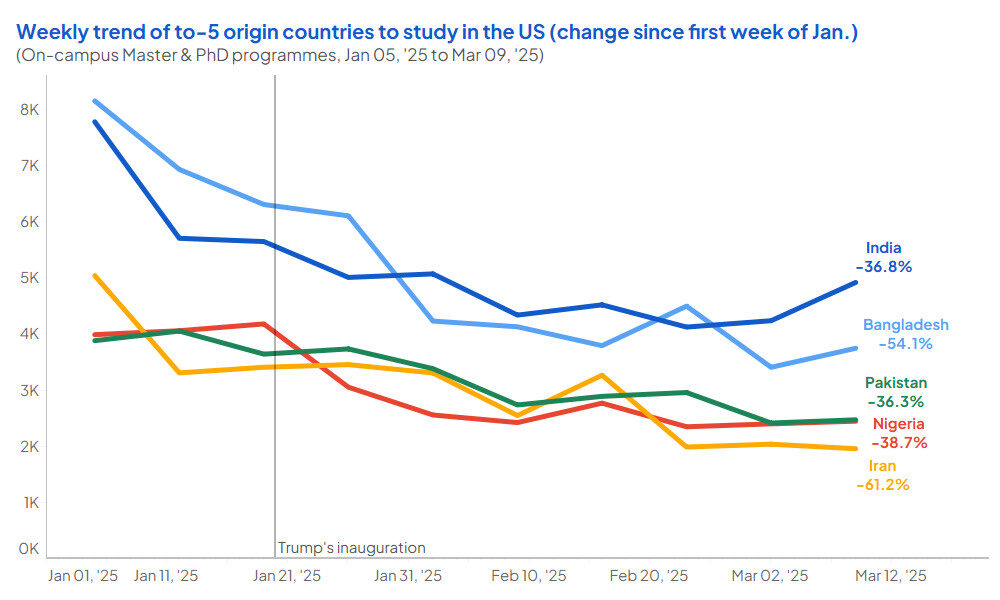
Only time will tell…
As of writing, the US higher education industry is experiencing a moment of potential transformation, but into what and in which direction university presidents, policymakers, and the current administration will go remains unknown. However, it remains clear that President Trump seeks to do good on his promise during the 2024 Presidential campaign on using funding as a bargaining tool to get US institutions to address antisemitism concerns, limit their commitments to diversity, equity, and inclusion (DEI), as well as targeting “any school pushing critical race theory, transgender insanity, and other inappropriate racial, sexual or political content”.
At the moment, the administration has begun to expressed that it would withhold funding in relation to various elite institutions such as Harvard University, Columbia University, and the University of Pennsylvania. In particular, the tactic has had the intended effect as Columbia University recently acquiesced to the administration’s demands on how to discipline students, restructure its disciplinary protocols, regulate on-campus masking, adjust its admissions practices, and, most notably, calling for Columbia to place its Department of Middle Eastern, South Asian, and African Studies into “academic receivership” for a minimum of five years. The latter was a rare and controversial measure in which a department is effectively stripped of its autonomy and placed under the oversight of an external university official. If the Columbia University had decided not to accept the administration’s requests, then it was at risk of losing approximately $400 million in federal funding, which generally allows US institutions to not only maintain their research excellence, but also continue conducting their research in important fields, especially within medical schools.
On the student end, both current and prospective students are affected by the administration’s policies, such as the funding freeze for a range of scholarships and exchange programmes, leaving as many as 10,000 students in financial and academic uncertainty, and a proposed travel ban which may impact the mobility of students from 43 countries. This is not to mention the proposed legislation to block, or at the least strictly regulate, Chinese students entering the US to study, through which the current administration seeks to avoid “the [Chinese Communist Party] to spy on our military, steal our intellectual property, and threaten national security”, as stated by Congressman Riley Moore who acts as the lead sponsor of the bill.
In more recent news, several students and graduates at US institutions also face the prospect of being detained and the deported from the country as the Secretary of State, Marco Rubio, has actively sought to revoke the visas of those that the administration deem to be in ‘opposition to American foreign policy’. One primary example of this is none other than Rumeysa Ozturk, a doctoral student at Tufts University and a Fulbright scholar from Türkiye, was detained after she participated in a student newspaper essay advocating for Palestinian rights and urging Tufts to divest from Israel. Following this, a U.S. senator ordered her visa to be revoked and she was forcibly taken by Immigration and Customs Enforcement agents.
In short, US institutions, academics, and students alike are facing a tidal wave of potential change, creating a hostile-like atmosphere were many are unsure how to act. On the one hand, the US still retains a stellar reputation in providing a high degree of education, but this may now come at the cost of abiding to the terms and conditions outlined by political actors. As Tarek Masoud, a political scientist at the Kennedy School at Harvard, said in a recent ‘Annals of Higher Education’ piece in the New Yorker that:
The real diversity of views brought by a real diversity of people… was American higher education’s strongest, truest claim to power.
This is now being subject to change in order to follow a particular, strict line of thought, and As international education becomes increasingly tied to geopolitics, the choices made by U.S. policymakers today will ripple through global innovation networks and the lives of students worldwide. Once seen as the unrivalled powerhouse of global education, the U.S. now finds itself at a crossroads. The question is no longer just about attracting international students—but whether the foundational values that once made it the top choice can weather today’s political storm.


